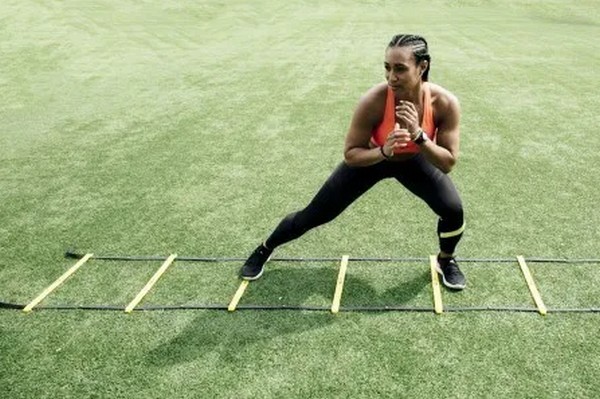
Agility Training
You don’t have to break the bank or install an expensive home gym to accomplish training that will result in the speediest, most agile you. You may even have most of the equipment on hand at home already. Here is your checklist for creating the speed and agility training of your dreams right in the comfort of your own home.
Climbing
Nothing boosts speed, agility, and leg strength like climbing. Remember Rocky, climbing up the steps of the Philadelphia Museum of Art? If you don’t have stairs or they are fairly dangerous for going up and down repeatedly, invest in a multi position ladder. Start with simple up and down on one step, alternating leading legs to equally build up the left and right legs. Do this for 5–8 minutes to warm up. Then, increase your speed and go up the entire staircase or ladder, then come down at a reduced speed. Do 20–30 sets of these stair sprints. Next, skip a stair or rung and go as fast as you can up the stairs or ladder 5–10 times. Skipping a stair or even two will build upper leg strength and increase agility. Cooldown by walking up and down the ladder or stairs 10 times.
Agility Course
If you invested in a ladder for the climbing portion of your training, you can simply lay the ladder flat on the floor to make a great makeshift agility course for yourself. Lay the ladder straight on the floor and for 3–5 minutes step between every rung of the ladder at a slower pace. This allows you to acclimate to the feeling of stepping through the ladder so that you can move through it with greater ease when you pick up the pace. Next, increase your speed moving back and forth stepping between every rung of the ladder for 8–10 minutes. Lastly, skip a rung, stepping between every other rung and increasing your speed as much as you safely can. Keep this up for 3–5 minutes. Once you have mastered the basic agility course, you can add a side step at the end for 3–5 minutes. Instead of facing forward, sidestep through the ladder rungs, criss-crossing your legs.
Jumps
Start the jumping portion of your training with 5–8 minutes of jump rope. If you’re new to jumping rope, you may need to start out slow. Gradually increase speed as you are able. Next, jump rope standing on just one leg for 1–2 minutes each leg. You may need to do the jump rope portion of your training outside depending on the height of your ceilings and available indoor space.
Next, find a step or use your ladder to jump up and down with both legs together. Start out doing this 20–30 times in a row and gradually build up to 100 times. Then, lay the ladder on its side or find something about a foot or slightly more tall that you can safely jump over. Jump over the ladder several times, alternating leading with the right and left foot. Then, jump back and forth over the ladder with both legs together for 2–3 minutes.
Stretching
Without stretching, it’s impossible to build agility. Stretching also makes you less injury-prone. In the case of yoga, stretching can also build strength, balance, and flexibility. Try ending your workout session with a short yoga class streamed on your computer. This can serve as your post-workout stretch as well as a cool-down.
Conclusion
For optimal results, try to do your home speed and agility training 2–3 days in a row and then give your body one recovery day. Committing to the workout for a longer term of a few months to a year or more will maximize results. Make sure you consult with your health professional before beginning a new workout program and make adjustments as needed to be sure you do not aggravate any injuries or existing problems.
